With high recent short-term bond yields, Investors have poured money into Vanguard Federal Money Market Fund (VMFXX), the largest US money market fund. But what happens when interest rates fall, the VMFXX yield falls, and VMFXX's investors miss out on bond price increases resulting from interest rate declines?
While Vanguard VMFXX could work for investors with short time horizons, there are alternatives that can enable investors to lock in income for longer time periods, to pay lower fees, and to benefit from capital appreciation opportunities.
This fixed income blog post discusses the eight reasons investors should NOT invest in Vanguard VMFXX and alternatives investors may want to consider.
- The much-advertised VMFXX 7 day yield misleads investors. It takes the fund's accrued interest over the last week and multiplies it by 52. The VMFXX yield does not accurately represent an investor's expected annual return in the way bond yields do.
- According to the December 2023 Fed dot plot, the US Federal Reserve is projecting the fed funds rate to decline 2.5 percentage points by the end of 2026. Should this occur, Vanguard VMFXX investors would see their income plunge and would not benefit from the rising bond prices that would likely accompany such a move.
- Vanguard VMFXX is not as safe as investors believe it is, as only 32.1% of its investments were in US Treasury obligations as of January 31, 2024. The rest were in repurchase agreements and agency obligations, two sectors previously bailed out by the US government.
- Vanguard VMFXX is not a fixed income investment given its ultra-short-term nature and the lack of visibility investors have in its future income distributions. As of August 31, 2023, 68.6% of VMFXX's investments had maturity dates between one and thirty days, creating significant reinvestment risk and uncertain future returns.
- The VMFXX management fee is understated, as it does not include the significant transaction costs VMFXX incurs to buy and sell securities. Owning individual bonds can drive significant savings compared to the recurring fees and costs incurred by VMFXX.
- In June 2023, Vanguard was fined and censured by the Financial Industry Regulatory Authority (FINRA) for overstating projected yields and annual income on nine money market funds along with other errors that went uncorrected despite 100 customer complaints.
- The Vanguard VMFXX website misleads investors by indicating that, as of January 31, 2024, 30.5% of VMFXX holdings were "Government Obligations," when, instead, these investments were Federal Home Loan Banks bonds and Federal Farm Credit Banks bonds, which are not guaranteed by the US government.
- There are compelling alternatives to VMFXX that offer investors higher potential returns, fixed coupons for long durations, lower fees, and a higher level of transparency.
REASON 1 NOT TO INVEST IN VANGUARD VMFXX
The VMFXX Yield Misleads Investors
The VMFXX 7 day yield (the "VMFXX yield") is the first performance-related number investors see when they visit the Vanguard VMFXX website, but it doesn't represent actual performance. As shown in Figure 1, the VMFXX yield stood at 5.27% on February 9, 2024, but this figure takes income the fund earned over the previous week and multiplies it by 52 to arrive at an annualized "yield."
The VMFXX yield is a "hypothetical" number, as discussed below, and does not represent the income investors will receive over the next year -- or even the next month. All bond fund investors must understand that income from these investments is not contractual. Bond funds, including Vanguard VMFXX, are not a substitute for individual bonds that pay a specific amount of coupon interest every six months.
Figure 1: "Above-the-fold" Area of Vanguard VMXX Website

Source: Numbers provided by Vanguard.com. Graphics created by Bondsavvy.
VMFXX Dividends Are Paid Monthly -- Not Weekly
We hear many investors say: "Why would I want to own bonds when VMFXX is paying over 5% interest?" The problem with this question is that it makes two incorrect assumptions. First, it assumes that the VMFXX 7 day yield is a fixed interest rate that will be paid over the course of the year. Second, it assumes that the credit quality of VMFXX is equal to, or better than, a portfolio of individual bonds. We'll discuss the first point in this section and the second point in Reason 8 of this fixed income blog post.
VMFXX investors receive distributions each month, which makes the relevance of the VMFXX 7 day yield a headscratcher.
Figure 2 shows the monthly VMFXX dividend history from January 3, 2022 to February 1, 2024. Over the course of the month, VMFXX collects income from the investments it owns (more on this later), which it then pays out on the first trading day of the following month. For example, on September 1, 2023, the VMFXX dividend per share was $0.00473, which came from income earned during the month of August 2023.
The VMFXX distribution yield of the September 1, 2023 payment was calculated by dividing $0.00473 by 31, the number of days in August 2023. The quotient ($0.000144) was the implied daily per-share VMFXX dividend for August 2023. Vanguard then multiplies $0.000144 by 365 days to arrive at a 5.27% annualized VMFXX distribution yield for its September 1, 2023 payment.
Of course, during any month, there will be multiple VMFXX 7 day yields, and these figures can differ from the distribution yield shown in Figure 2.
Figure 2: VMFXX Dividend History-- January 3, 2022-February 1, 2024
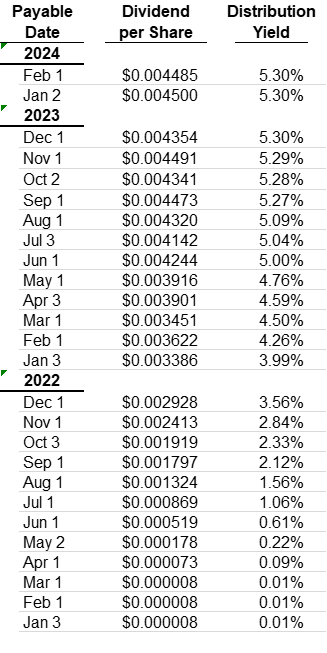
Source: Vanguard
Bondsavvy Subscriber Benefit
Money market funds are not sufficient for long-term income investors. Individual bonds enable investors to lock in income for several years to several decades.Get Started
VMFXX Dividends Can Vary Significantly from Month to Month
A challenge of owning individual bonds, such as corporate bonds and US Treasurys, can be how volatile bond prices can be. This will vary based on the bond's time to maturity, the issuing company's creditworthiness, US Treasury yields, and other market forces. What will not vary, however, assuming no default, is the income investors receive from the bond, which is a contractual amount typically paid semiannually.
VMFXX dividends, on the other hand, are unreliable and inconsistent -- not what the doctor ordered for an income investment. When interest rates were low, the VMFXX yield was close to zero, as shown in Figure 2. While the VMFXX yield is higher now, the distribution yields shown in Figure 2 are monthly figures that can change quickly.
As of August 31, 2023, 60.4% of VMFXX holdings had maturities of one to seven days. Therefore, a significant portion of VMFXX investments are replaced during the month. As this happens, the monthly VMFXX distribution yield shown in Figure 2 could vary from the advertised VMFXX 7 day yield.
Changing interest rates and the mismatch between the VMFXX 7 day yield and actual VMFXX dividends paid create a high level of uncertainty for Vanguard Federal Money Market Fund investors.
The VMFXX 7 Day Yield Is Based on "Hypothetical Income" per Vanguard
As shown in Figure 1, there are blue hyperlinks regarding the "7 day SEC Yield" Vanguard VMFXX site visitors can click for more information. These hyperlinks provide the following information on the VMFXX yield. If you need to read it multiple times for it to make sense to you, you're not alone. We have added italics to emphasize certain areas.
Figure 3: Vanguard's explanation of the VMFXX 7 Day SEC Yield
SEC Yield
"A non-money market fund's SEC yield is based on a formula developed by the SEC. The method calculates a fund's hypothetical annualized income as a percentage of its assets.
A security's income, for the purposes of this calculation, is based on the current market yield to maturity (for bonds) or projected dividend yield (for stocks) of the fund's holdings over a trailing 30-day period. This hypothetical income will differ (at times, significantly) from the fund's actual experience. As a result, income distributions from the fund may be higher or lower than implied by the SEC yield.
The SEC yield for a money market fund is calculated by annualizing its daily income distributions for the previous 7 days."
Got all that?
Advertising the Vanguard VMFXX 7 day yield is tantamount to an investor owning a corporate bond that went up 10% in one week and touting a 520% investment return. The only difference being that the bond investor with the 10% one-week return achieved an actual return, and the investor could sell her bonds after one week at a 10% profit.
Yes, Vanguard does disclose how it calculates the VMFXX yield in a hyperlink; however, given the prominent position Vanguard accords the VMFXX yield in its advertising materials, it's no wonder many investors falsely believe the VMFXX yield and a bond's YTM are similar metrics.
Bondsavvy Subscriber Benefit
While some individual bond prices can be volatile, their income is contractual and fixed until the maturity date.Get Started
REASON 2 NOT TO OWN VANGUARD VMFXX
The Fed Is Projecting Interest Rates To Fall Nearly 2.5% by Year-End 2026, Which Would Materially Lower the VMFXX Yield
The VMFXX yield is closely tied to the US federal funds rate, which is set by the US Federal Reserve's Federal Open Market Committee ("FOMC"). As the US Federal Reserve raised the target fed funds rate 5.25 percentage points (or 525 "basis points" or "bps") from March 2022 to July 2023, the VMFXX yield followed suit, as shown in Figure 4. The VMFXX yield has benefited from the sharp interest rate hikes and will likely do so until the fed funds rate is lowered.
As discussed later in this section, however, the Fed, per the December 2023 Fed dot plot, is projecting the fed funds rate to fall nearly 2.5 percentage points by year-end 2026. Given the close correlation between the fed funds rate and the VMFXX yield, VMFXX dividends could go down just as fast as they went up.
Figure 4: VMFXX Distribution Yield vs. Effective Fed Funds Rate ("EFFR") -- March 1, 2022-September 6, 2023

Sources: Vanguard.com and the Federal Reserve Bank of New York.
Not only would reductions in the fed funds rate lower the VMFXX yield, but also VMFXX investors would not benefit from any bond price increases potentially driven by lower interest rates.
VMFXX Returns Are 100% from Income
With Vanguard VMFXX, the only return it generates is from income, as the fund seeks to maintain a $1.00 net asset value per share every day. There is no such thing as capital appreciation opportunities with Vanguard VMFXX.
Figure 5 shows the daily closing price of Vanguard VMFXX for the ten years ending September 2, 2023:
Figure 5: Vanguard VMFXX Closing Price -- September 2, 2013-September 2, 2023
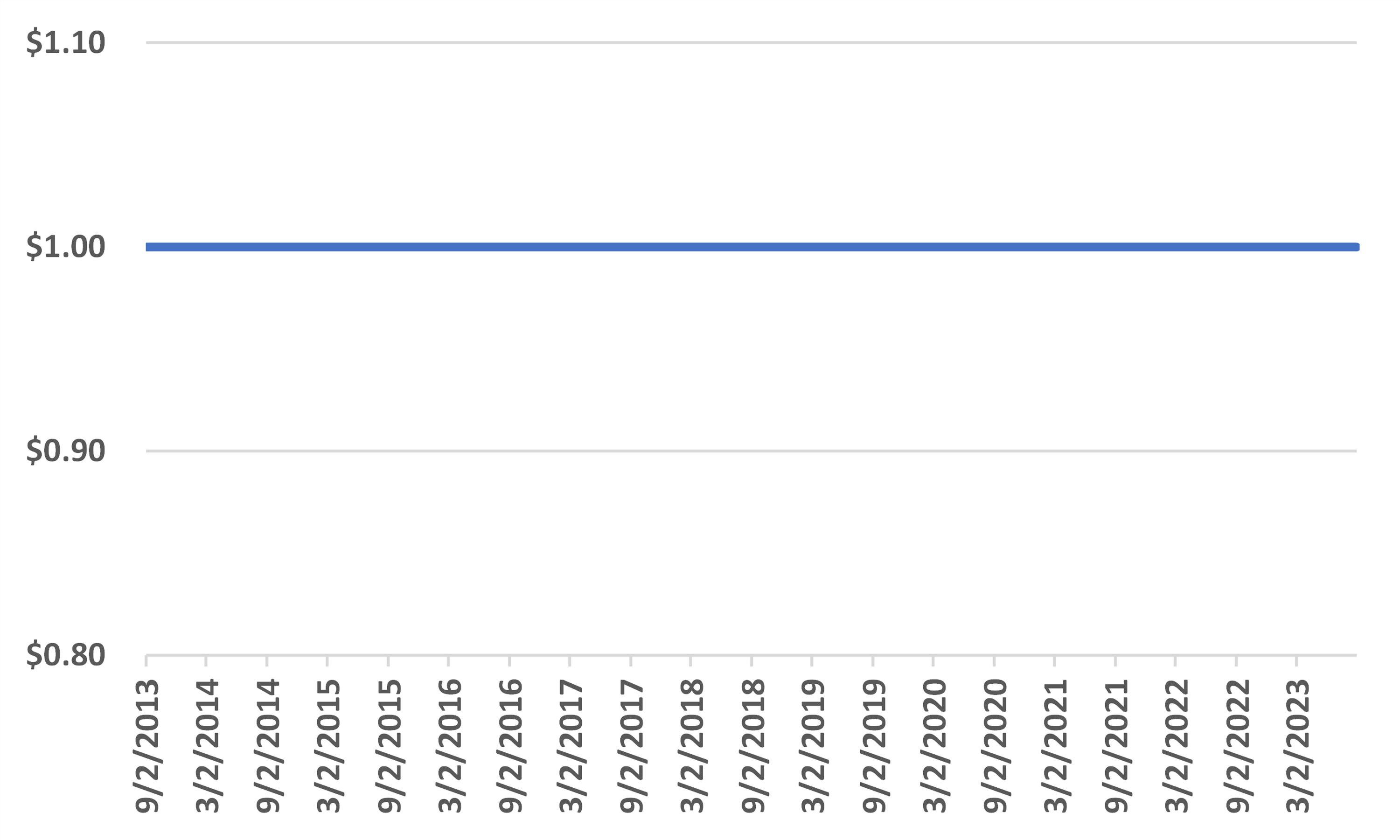
While VMFXX lacks the upside of bonds, especially those trading at a significant discount to par value today, they also generally lack the pricing volatility. That said, since income generates 100% of VMFXX returns, the variability of VMFXX dividends can make VMFXX less compelling than individual bonds, which offer fixed coupon payments until a specified maturity date.
The Fed Dot Plot Shows the Fed Funds Rate Falling 2.5 Percentage Points by Year-End 2026
Each quarter, the US Federal Reserve publishes the FOMC Summary of Economic Projections, the most recent of which it released December 13, 2023.
While there are only 12 voting members of the FOMC at any given time, all 19 FOMC participants provide economic projections that are summarized in the FOMC Summary of Economic Projections. Included in these projections are 1) changes in GDP, 2) the unemployment rate, 3) PCE inflation, 4) Core PCE inflation, and 5) the fed funds rate.
Figure 6 shows the FOMC participants' projections for the fed funds rate, which are also known as the Fed dot plot. Each dot represents an estimate from one FOMC participant. Above each set of dots, we show the median projection for each year-end. Per the December 2023 Fed dot plot, the median estimate for the fed funds rate falls from 5.4% at the end of 2023 to 2.9% at the end of 2026.
Figure 6: Midpoint Estimate of Federal Funds Target Range for Each FOMC Participant -- the December 2023 Fed Dot Plot
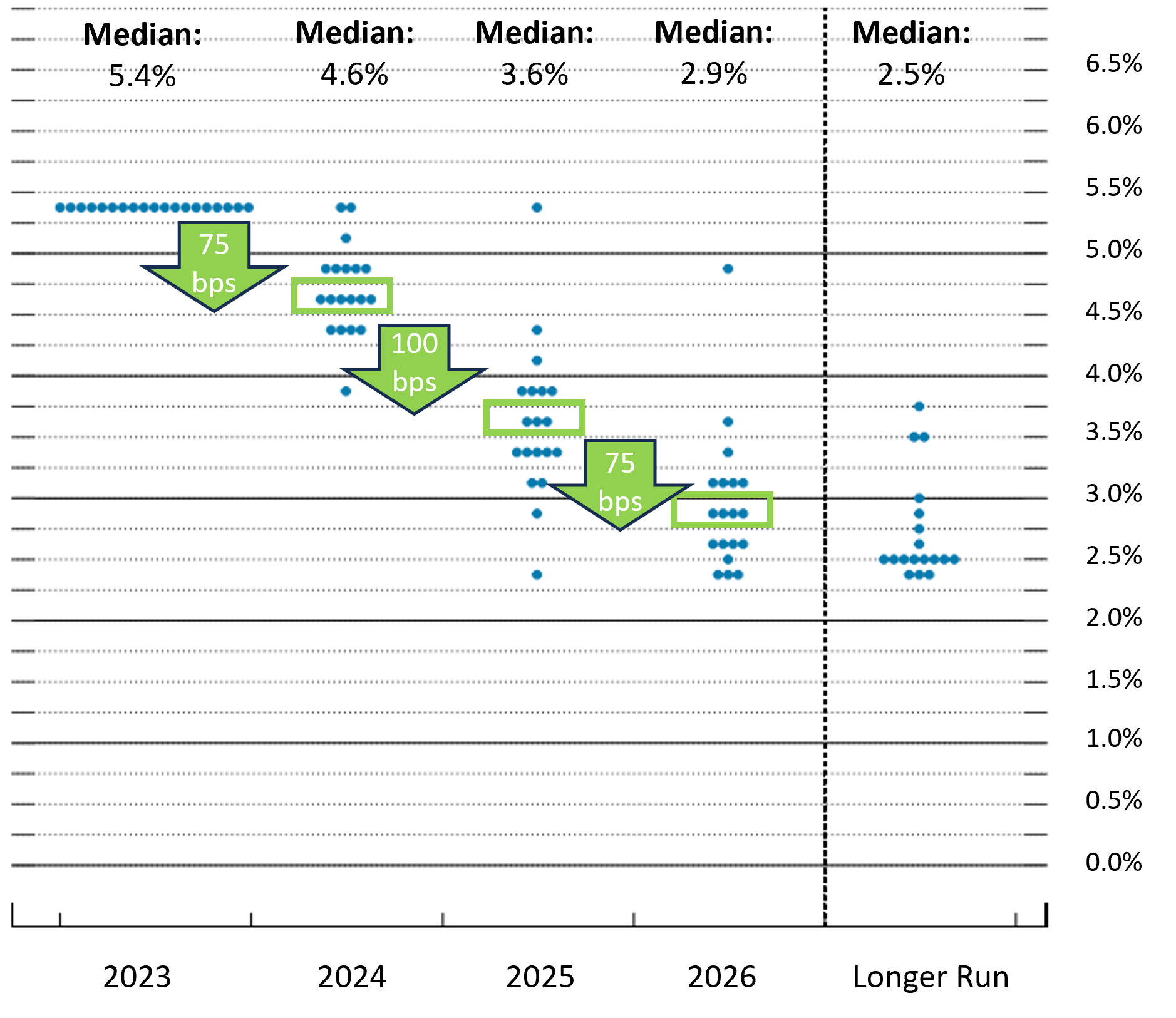
Source: December 13, 2023 US Federal Reserve Summary of Economic Projections.
Of course, within the 19 Fed dot plot dots, we do not know which 12 will vote at future meetings, but this gives us the best estimate of where all
FOMC participants' heads were at on December 13, 2023. Based on the December 2023 Fed dot plot, the Fed is expected to drop the fed funds rate by 75, 100, and 75 basis points in 2024, 2025, and 2026, respectively.
As the fed funds rate falls, we would expect the VMFXX yield to fall in lockstep.
Bondsavvy Subscriber Benefit
Investors owning a 10-year bond know the exact amount of income they will receive until maturity. The same cannot be said for Vanguard VMFXX investors, who live at the whim of the fed funds rate.Get Started
REASON 3 NOT TO OWN VANGUARD VMFXX
Vanguard VMFXX Is Not as Safe as Many Think It Is
We believe investments in individual US Treasurys and the highest-quality US corporate bonds (think Alphabet, Microsoft, and Wal-Mart) represent a higher credit quality than that of Vanguard VMFXX. As of January 31, 2024, 67.9% of VMFXX investments were held in either repurchase agreements (also known as "repos;" we will discuss more about these later) and bonds of government-sponsored entities (GSEs) such as the Federal Home Loan Banks ("FHLB") and Federal Farm Credit Banks Funding Corp. ("Farm Credit Banks").
The repo market was bailed out by the US Federal Reserve in September 2019 and certain GSEs, such as Fannie Mae, were bailed out by the US government during the 2008 Financial Crisis. The bonds of GSEs such as FHLB and Farm Credit Banks are not guaranteed by the US government despite Vanguard referring to them as "Government Obligations" on the VMFXX website.
US Treasurys Are Only 32% of VMFXX and Investments Can Swing Wildly Across Asset Classes
One of the many benefits of owning individual bonds vs. bond funds is that individual bond investors know exactly what they are investing in. Bond fund investors, on the other hand, are at the whim of money managers such as Vanguard, as the composition of mutual funds and ETFs can change by the day.
As of January 31, 2024, the breakdown of VMFXX holdings by asset class was: repurchase agreements (37.4%), GSE obligations (30.5%), and US Treasury obligations (32.1%). As shown in Figure 7, the composition of Vanguard VMFXX has changed dramatically through the years.
Bondsavvy Subscriber Benefit
Owners of individual bonds know exactly what is in their portfolios every day of the week. Vanguard VMFXX investors have to play a guessing game, as the fund's holdings are always changing.Get Started
Per Figure 7, repurchase agreements represented only 6.3% of VMFXX holdings on August 31, 2020, but then repos skyrocketed to 64.0% of Vanguard VMFXX on August 31, 2022. US Treasury obligations reached a high of 75.9% on August 31, 2020; however, by August 31, 2022, US Treasury obligations accounted for only 16.6% of VMFXX holdings.
Figure 7: VMFXX Holdings Breakdown by Asset Class -- August 31, 2016-August 31, 2023
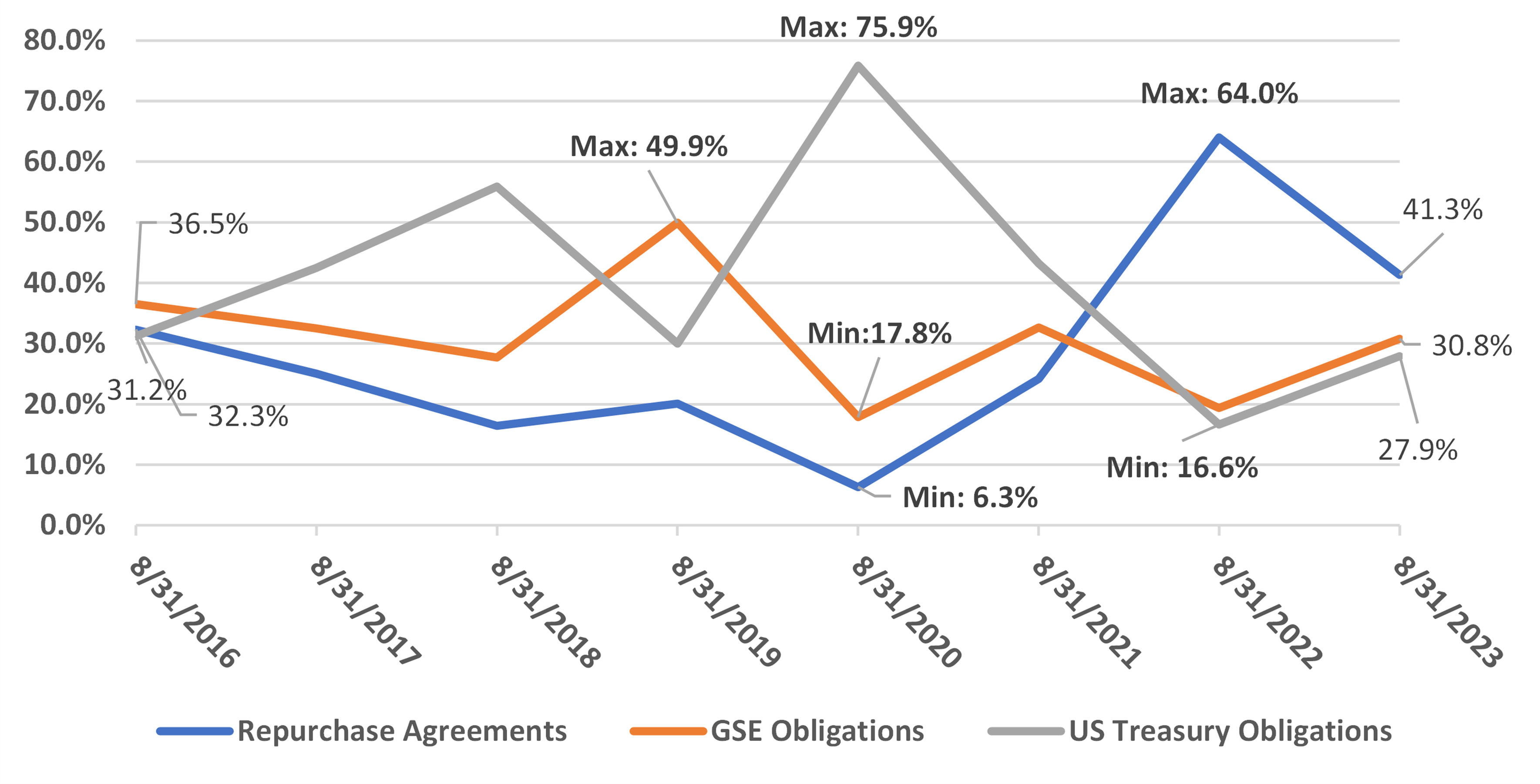
Source: Vanguard SEC filings and public information. Bondsavvy calculated percentages for August 31, 2020, 2021, and 2022 based on Vanguard filings.
Few Individual Investors Understand Repurchase Agreement Risks
Before making any investment, individual investors must ask themselves if they truly understand its risks and potential returns.
As shown in Figure 7, investors do not know, from day to day, what is held in VMFXX. The largest holdings have recently been in repurchase agreements, which we believe are investments understood by few individual investors. The Wall Street Journal has an excellent repo market explainer video for those looking to gain a better understanding. The video also reviews how the Federal Reserve had to bail out the repo market in September 2019.
Each repo agreement Vanguard VMFXX enters into is with a counterparty, whereby VMFXX lends cash to either a commercial bank or the Federal Reserve Bank of New York. Like the holdings of VMFXX, its counterparties are also changing over time. For example, on August 31, 2016, the Federal Reserve Bank of New York was the counterparty in 26.3% of VMFXX repurchase agreement investments compared to 95.0% on August 31, 2022.
Per Vanguard VMFXX's Form N-MFP2 filed with the US Securities and Exchange Commission ("SEC") on September 8, 2023, select repurchase agreement counterparties included Credit Agricole Corporate & Investment Bank SA, TD Securities (USA) LLC, Sumitomo Mitsui Banking Corp., and Standard Chartered Bank.
While Vanguard VMFXX repurchase agreements are typically collateralized with US Treasury obligations, there is still counterparty risk. The exposure to each counterparty regularly changes, so it's quite difficult for investors to assess the risk of these repurchase agreements. Given that repurchase agreements were Vanguard VMFXX's largest investment as of August 31, 2023, individual investors must ask themselves whether putting money into such a repo-heavy fund is a good move.
REASON 4 NOT TO OWN VANGUARD VMFXX
VMFXX Is NOT a Fixed Income Investment Given Its Ultra-Short-Term Holdings
For an investment to be considered "fixed income," there needs to be some element of "fixed" to it. Fixed income investments come in all shapes and sizes, from a 1 month US Treasury bill to a 30 year Microsoft corporate bond.
As discussed above, the VMFXX yield is a hypothetical number given how quickly interest rates can move and the short-term nature of its investments. Investors who own a 2 year US Treasury note with a YTM of 5.00% know the amount of interest they will receive between now and maturity, the dates of such interest payments, and the date and amount paid at maturity.
All of these facts are unknown to Vanguard VMFXX investors. As shown in Figure 8, on August 31, 2023, 60% of Vanguard VMFXX's investments were in securities with maturity dates between one and seven days. Since nearly two-thirds of the portfolio matures each week, these investments will need to be replaced with other investments that are unknown to VMFXX investors. The yields of these incoming investments are unknown to investors, making guesswork of future VMFXX dividends.
Figure 8: Vanguard VMFXX Maturity Date Distribution on August 31, 2023
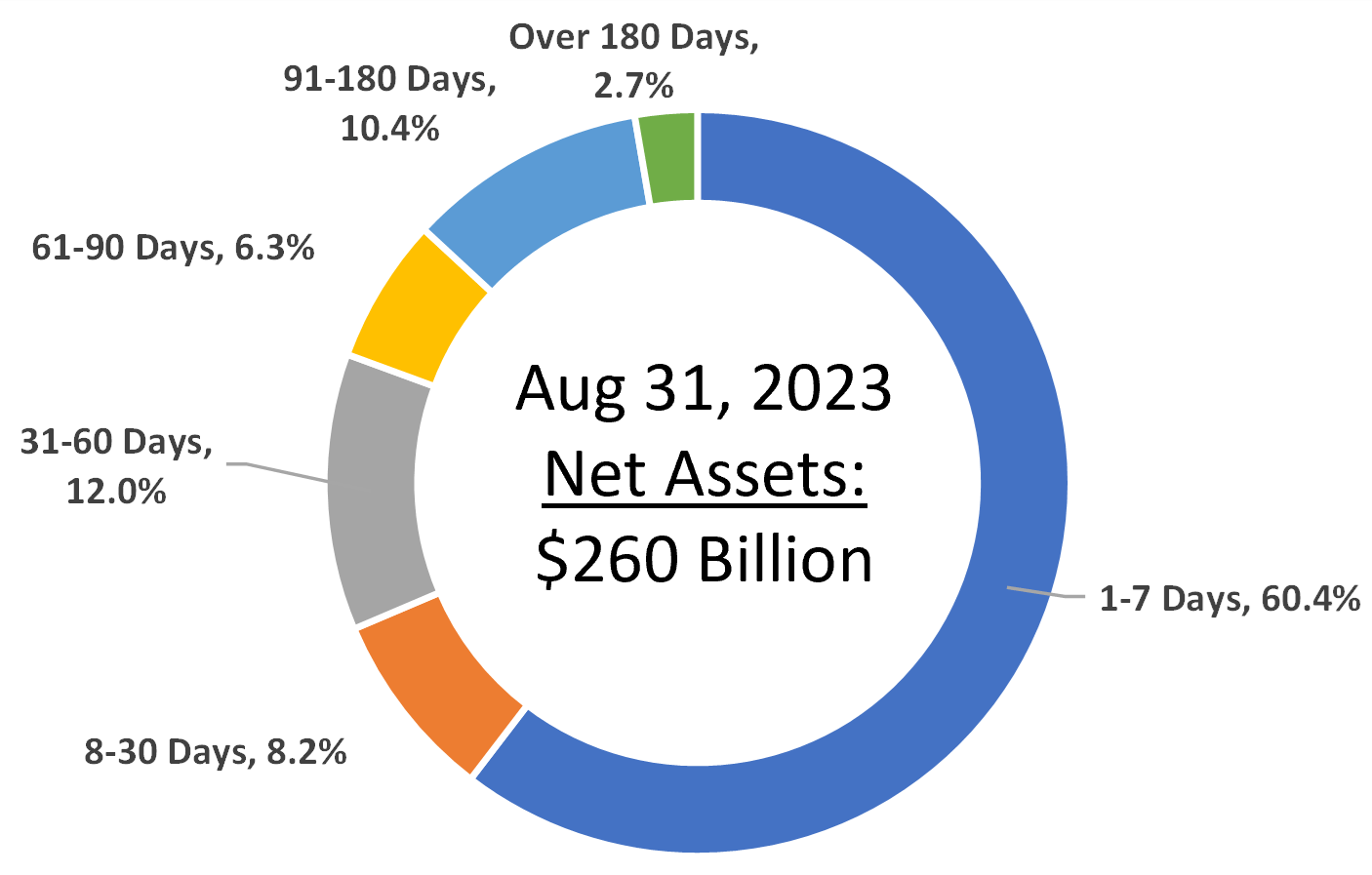
Source: Vanguard Money Market Funds Annual Report dated August 31, 2023.
In addition to VMFXX's high portfolio turnover that limits visibility of the VMFXX yield, it also significantly increases the transaction costs Vanguard VMFXX incurs to purchase new investments and sell existing ones. Despite knowing what these transaction costs are, Vanguard does not disclose them to investors.
While Vanguard likes to tout funds with 'low expense ratios' like the 0.11% VMFXX expense ratio, we believe the actual costs investors incur to invest in Vanguard VMFXX are materially higher than the VMFXX expense ratio, as we discuss further in Reason 5.
REASON 5 NOT TO OWN VANGUARD VMFXX
Vanguard Understates VMFXX Expenses by Not Disclosing VMFXX's Transaction Costs
Vanguard has built its business on claiming to be a "low-cost provider" of mutual fund and ETF products. The problem with this is that the VMFXX expense ratio of 0.11% as of December 22, 2023 excludes one of the most basic costs of operating a mutual fund: securities transaction costs.
All bond fund managers know what these costs are, as they all have Transaction Cost Analysis (TCA) reports that will show their transaction costs down to the penny. Somehow, however, the Big Money lobby has convinced regulators that funds don't have to disclose this material cost of doing business. Buying and selling securities is fundamental to managing money. Funds need to disclose these costs so investors understand the true cost of investing in mutual funds and ETFs.
Figure 9: Big Money Lobbyist Convinces Government That Bond Funds Shouldn't Disclose Transaction Costs to Investors
In Vanguard VMFXX's case, there is a table in the fund's August 31, 2023 annual report that shows calculations of the VMFXX expense ratio. If you read the fine print, however, you will see "Note that the expenses shown in the table are meant to highlight and help you compare ongoing costs only and do not reflect transaction costs incurred by the fund for buying and selling securities."
This is tantamount to a retailer not reporting the cost of transporting products to its stores. Reporting the VMFXX expense ratio before transaction costs is a shameless practice that needs to end.
How Much Is the Vanguard VMFXX Expense Ratio Before Transaction Costs?
On August 31, 2023, VMFXX reported a net asset value of $260 billion. It reported "total expenses" of $256.9 million for the 12 months ending on the same date. These expenses included $232.6 million of "Management and Administrative" and $18 million for "Marketing and Distribution."
This, of course, excludes transaction costs, which are likely significant given the high VMFXX portfolio turnover
driven by the ultra-short maturities of its holdings.
Investors in Individual Bonds Can See All the Costs They Incur
When investors buy bonds online, they can see all the costs they incur, including the bid-ask spread and any brokerage commissions. For most online brokerages, buying and selling US Treasurys is free. If an investor is looking for a short-term place to put money, short-dated US Treasurys that have no trading costs could offer advantages compared to Vanguard VMFXX. Corporate bonds also offer advantages over VMFXX. We will compare VMFXX to select US Treasurys and corporate bonds in Reason 8 of this fixed income blog post.
REASON 6 NOT TO OWN VANGUARD VMFXX
Vanguard Was Recently Fined for Miscalculating Yield and Income on Vanguard Money Market Accounts
As reported in Investment News on May 23, 2023, FINRA ordered Vanguard to pay $800,000 for "issuing misleading account statements to money market customers and failing to respond to [the customers] when they indicated something was wrong." According to the May 2023 FINRA Order, Vanguard overstated the estimated yield and annual income for certain money market funds on approximately 8.5 million account statements. This occurred from November 2019 to September 2020.
Example of Vanguard VMFXX Yield Being Miscalculated
As noted in an example provided in the FINRA Order, in September 2020, Vanguard account statements displayed an estimated VMFXX yield of 1.87%, when it was actually 0.06%, or 31 times less. From November 2019 to October 2020, approximately 50 customers contacted Vanguard to alert it of the miscalculated VMFXX yields.
Figure 10: Vanguard customer realizes VMFXX yield on his statement was 31x higher than actual

According to the FINRA Order, Vanguard "failed to promptly investigate whether the yield data used to calculate the estimated yield and estimated annual income for money market funds on account statements was correct." It wasn't until October 2020 -- 11 months after the first customer complaint -- that Vanguard corrected the error.
Figure 11: Vanguard Management Ignored Repeated Calls from Customers on Incorrect VMFXX Yields

Other Vanguard Investment Returns Miscalculations
Vanguard was fined for errors in other investment returns calculations as part of the FINRA Order.
In one set of errors, if a customer deposited a check into an account on the last business day of the month, the statement's performance area recorded this deposit as an increase in market value instead of an account deposit. The subsequent monthly statement would then record the deposit as a loss in market value. This error, according to the FINRA Order, affected approximately 23,000 statements from at least October 2019 until May 2021.
From October 2019 to March 2021, Vanguard received 50 customer calls and emails regarding this issue and one other related to account inaccuracies in the case of corporate actions such as stock splits. Again, these myriad customer calls resulted in no action by Vanguard until it finally corrected the errors in May and June 2021.
While we don't believe these errors are as serious as Vanguard misstating Vanguard money market yields on over 8 million account statements, Vanguard's yearslong lack of prompt corrective action should be of concern to investors.
Glacial Carriage of Justice and a Slap on the Wrist for Vanguard
From the first knowledge of money market yield calculation issues in November 2019, it took nearly four years for Vanguard to have to pay a fine related to this matter. While some fine is better than none, $800,000 seems light when compared to the $232.6 million Vanguard VMFXX charged investors in "Management and Administrative" fees for the year ending August 31, 2023.
If an $800,000 fine and related censure is the only consequence, it's doubtful such 'punishment' is enough to thwart similar behavior in the future. After all, Vanguard knew about its errors as far back as 2019, but it elected to do nothing. This is inexcusable.
While 50 Vanguard customers contacted the company to alert it of the money market yield issues, hundreds of thousands did not. They likely saw the high yields on their statements and may have invested more money into Vanguard VMFXX. While we hope this episode caused Vanguard to address these and similar issues, the long-delayed rounding-error fine and corresponding censure don't seem like much of a deterrent.
REASON 7 NOT TO OWN VANGUARD VMFXX
Vanguard Misleads Investors by Calling GSE Debt a "Government Obligation"
As feared and expected, Vanguard appears to be 'right back at it,' this time by referring to debt issued by government-sponsored entities (GSEs) as "Government Obligations" when such debt is not a government obligation. This is the classic Vanguard marketing machine, where it seeks to have investors believe an investment's risk is lower than it actually is. If it has to pay a small fine and have some professional embarrassment while getting people to invest billions in VMFXX, so be it.
Vanguard's mischaracterizing GSE debt as a government obligation and its ignorance of the 100 customer complaints discussed in Reason 7 raise legitimate concerns over Vanguard's values and culture.
GSE Debt Is NOT a US Government Obligation
As of August 31, 2023, VMFXX held billions in bonds issued by Federal Home Loan Banks ("FHLB") and Federal Farm Credit Banks Funding Corp. ("Farm Credit Banks"). As explained on the Federal Housing Finance Agency website, in the "Consolidated Obligations" section, the FHLB bonds "are not guaranteed or insured by the federal government."
Figure 12 shows a screenshot taken of the Vanguard VMFXX website on February 11, 2024, which shows the fund's alleged weighted exposures to different types of investments. As highlighted, it indicated 30.5% of the fund's investments were "US Govt. Obligations" even though these were bonds issued by FHLB and the Farm Credit Banks, which are not guaranteed by the US government.
Figure 12: Screenshot of Vanguard Website Showing Alleged Vanguard VMFXX Investment Exposures as of January 31, 2024
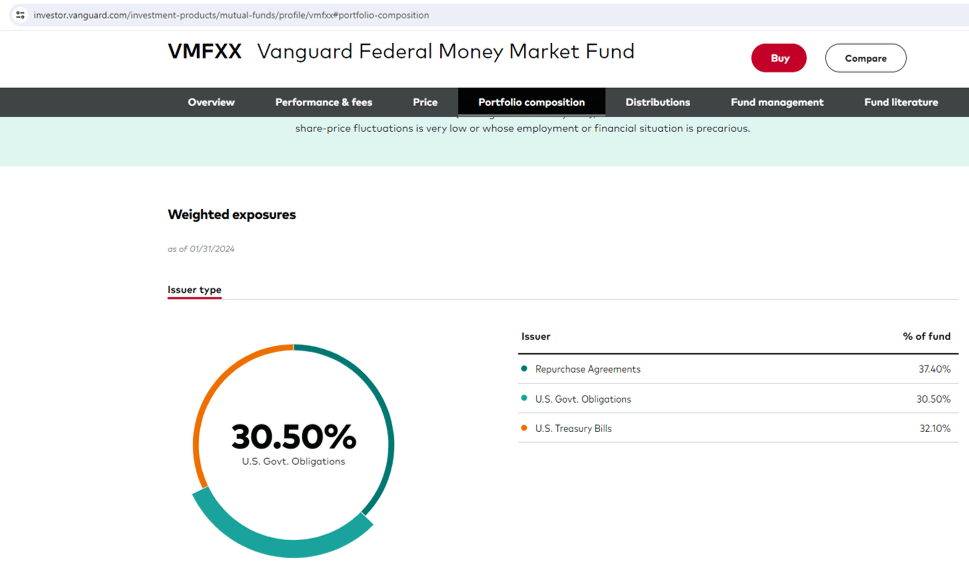
Source: Vanguard VMFXX website
In Figure 13, we have excerpted a portion of the Schedule of Investments shown in the Vanguard Money Market Funds February 28, 2023 semiannual report. On other pages of its Schedule of Investments, Vanguard provides detail on VMFXX's repurchase agreements and the US Treasurys it owns. We show Figure 13 so that investors are clear on what investments, summarized in Figure 12, Vanguard is mischaracterizing as "US Govt. Obligations."
Figure 13: Excerpt of VMFXX Schedule of Investments -- February 28, 2023

Source: Vanguard Money Market Funds Semiannual Report, February 28, 2023
Vanguard VMFXX wants to appear as safe as possible, which is why its website refers to GSE debt as a government
obligation even though it is not. While the 2023 US debt ceiling crisis showed investors that US Treasurys
aren't as safe as they used to be, obligations of the US government, such as US Treasury bills, are still among
fixed income investments with a low risk of default.
The VMFXX website is the most public place Vanguard provides information on VMFXX. We urge Vanguard to correct this issue so it does not continue to mislead investors.
We are big proponents of understanding what you are investing in. Given the large concentration of FHLB bonds within Vanguard VMFXX, we encourage investors to study FHLB financial information prior to making investments into VMFXX.
REASON 8 NOT TO BUY VANGUARD VMFXX
There Are Alternatives to VMFXX That Offer Higher Potential Returns, Higher Credit Quality, and Lower Fees
All investments have weaknesses and drawbacks. We discuss corporate bonds advantages and disadvantages relative to bond funds, muni bonds, and stocks in a separate Bondsavvy fixed income blog post.
In this section, we will compare Vanguard VMFXX to other investment alternatives, including select US Treasurys and individual corporate bonds. Bondsavvy does not provide personalized advice, so certain pros and cons may be more or less applicable to different investors.
US Treasurys and Select Corporate Bonds Offer Higher Potential Returns and Credit Quality Than VMFXX
Figure 14 shows yields to maturity (YTMs) of select US Treasurys and corporate bonds of different maturity dates. Since there is no Vanguard VMFXX maturity date or fixed coupon rate, there is no Vanguard VMFXX yield to maturity. With the individual bonds, however, we can see there are compelling alternatives to VMFXX.
Higher Potential Returns of US Treasurys and Select Corporates vs. VMFXX
For example, on February 9, 2024, an investor could purchase a 1-year US Treasury (CUSIP 91282CGN5) with a YTM of 4.75%. She could also purchase a 2-year US Treasury (CUSIP 91282CGL9) or a 2.5-year Microsoft bond (CUSIP 594918BR4) with YTMs of 4.41% and 4.43%, respectively. The US Treasury '26 Note and the Microsoft '26 bond enable investors to lock in yields of approximately 4.4% for the next two years. Should the fed funds rate fall 175 basis points by year-end 2025 as projected by the December 2023 Fed dot plot, we would expect these returns to outperform those of Vanguard VMFXX.
Please note that corporate and US Treasury bonds can achieve total returns that can exceed their YTMs, as we discuss in our fixed income strategy and corporate bond returns pages.
Figure 14: Comparison of VMFXX to Select US Treasurys and Corporate Bonds. Pricing as of 5:00pm EST on February 9, 2024
Investment |
Years to Maturity from 2/9/2024 |
CUSIP |
YTM* |
Price as % of Par Value* |
Bond Rating |
Min Quantity* |
| Vanguard VMFXX | No maturity date | 922906300 | N/A | N/A | N/A | $3,000 |
| US Treasury Note 4.625% 2/28/25 | ~ 1 year | 91282CGN5 | 4.75% | 99.871 | Aaa/AA+ | $5,000 face value |
| US Treasury Note 4.00% 2/15/26 | ~2 years | 91282CGL9 | 4.41% | 99.214 | Aaa/AA+ | $5,000 face value |
| Microsoft 2.40% 8/8/26 | ~2.5 years | 594918BR4 | 4.43% | 95.269 | Aaa/AAA | $2,000 face value |
| US Treasury Bond 3.000% 2/15/47 | 23 years | 912810RV2 | 4.52% | 78.390 | Aaa/AA+ | $5,000 face value |
| Microsoft 4.25% 2/6/47 | 23 years | 594918CA0 | 4.75% | 93.035 | Aaa/AAA | $2,000 face value |
| Fedex 4.40% 1/15/47 | 23 years | 31428XBN5 | 5.61% | 84.450 | Baa2/BBB | $2,000 face value |
*Source: Fidelity.com
Investors looking to lock in yields for a longer time period and to have opportunities for capital appreciation could evaluate longer-dated US Treasury and corporate bonds. As shown in Figure 14, Microsoft has a higher credit rating than the US Treasury, and the Microsoft 4.25% 2/6/47 bond has a YTM that is 23 basis points (0.23 percentage points) higher than the US Treasury bond with a similar maturity date. Should long-term US Treasury yields drop over the coming years, we would expect both the Microsoft '47 and US Treasury '47 bonds to increase in value. Of course, this upside potential does come with materially higher pricing volatility relative to the shorter-dated bonds shown in Figure 14.
For investors seeking a higher yield and who are willing to invest in bonds rated below the highest-rated bonds, the Fedex 4.40% '47 bond offers a nearly one-percentage-point higher yield compared to the Microsoft '47 bond. In addition, should long-term US Treasury yields fall by one percentage point in the near term, assuming no change in credit spread, we would expect the Fedex '47 bond price to increase approximately 10 points.
None of the investments in Figure 14 are currently on the Bondsavvy investment recommendation list. Purchase a Bondsavvy subscription to see all of our current and past corporate bond recommendations. Read our How To Build a Bond Portfolio blog post for ten dos and don'ts on building a fixed income portfolio.
Higher Credit Quality of US Treasurys and Select Corporate Bonds vs. VMFXX
VMFXX does not have a bond rating; however, we believe individual bonds issued by the US Treasury and high-credit-quality companies such as Microsoft have higher creditworthiness than the repo- and GSE-debt-heavy VMFXX. In the case of US Treasury and Microsoft bond investments, investors know exactly what they are investing in and can assess the risk and potential return. As shown throughout this article, the VMFXX holdings are always changing, and its credit quality has fallen as the amount of US Treasury investments has become a lower percentage of the fund's investments.
Bondsavvy Subscriber Benefit
Evaluating credit quality is one of many pieces in Bondsavvy's investment analysis. Our goal is to recommend corporate bonds trading at compelling values that can achieve strong long-term total returns.Get Started
US Treasurys and Corporate Bonds Offer Lower Fees Than VMFXX
Even as VMFXX's net asset value has grown from $38.8 billion on August 31, 2016 to $260 billion on August 31, 2023, the VMFXX expense ratio has held steady at 0.11%. When adding in transaction costs not disclosed by the fund, the actual expense ratio is likely closer to 0.15%.
These VMFXX fees are recurring and don't go away.
On the other hand, online bond investors who own US Treasurys generally do not pay to buy and sell Treasurys and do not incur recurring management fees. Corporate bond investors will pay transaction fees, generally $1 per $1,000 face value per bond on online bond trading platforms. Of course, corporate bond investors who hold bonds to maturity would only pay the transaction fee when they purchase the bond.
Despite the Vanguard drumbeat of it being the "low-cost provider," as shown in Figure 15, VMFXX fees are substantially higher than those incurred by investors in individual bonds. Figure 15 shows an illustrative example of the fees incurred by online bond investors vs. those of Vanguard VMFXX for an initial $50,000 investment. We show two cases for VMFXX: one with the reported 0.11% VMFXX expense ratio and another with an illustrative 0.15% expense ratio, which we believe closer reflects the all-in expense ratio when transaction costs are included.
Figure 15: Illustrative Investment Fee Analysis for Initial $50,000 Investment
Investment |
Fees Over Five Years |
Assumptions |
| VMFXX Expense Ratio @ 0.11% | $303 | Annual year 1-5 returns of 5%, 4%, 3%, 2.5%, and 2.5%, respectively |
| VMFXX 0.15% All-in Expense Ratio | $413 | Same return assumptions; however, we assume a higher 0.15% VMFXX expense ratio to account for VMFXX transaction costs |
| Online US Treasurys | $0 | Generally, online bond trading platforms do not charge transaction fees for US Treasurys |
| Online Corporate Bonds: Hold to Maturity | $50 | $1 per $1,000 of face value paid at purchase |
| Online Corporate Bonds: Sell Bonds Before Maturity | $100 | $1 per $1,000 of face value paid at purchase and sale |
Since Vanguard charges expenses on the total amount invested in VMFXX, we make five-year VMFXX investment return assumptions. Individual bond fees are off the face value, so the transaction fees do not change if the bond price increases or decreases in value.
As noted above, US Treasurys are generally free to trade on online bond platforms. For corporate bonds, an investor holding a $50,000 investment to maturity would incur $50 of transaction costs at purchase. An investor selling bonds before maturity would incur the $50 charge during both the purchase and sale transactions.
Conclusion on Eight Reasons Not To Own Vanguard VMFXX
Many investors assume that money market funds such as Vanguard VMFXX are money good and typically an optimal place to invest short-term cash. Our analysis peels back the onion on Vanguard VMFXX to show what it is and what it is not. We also show how certain alternatives to VMFXX could generate higher returns at a lower cost.
As Vanguard VMFXX has grown nearly 7x in size since August 31, 2016, the fund faces the same problems many other mega funds face: where to invest hundreds of billions of dollars at attractive returns. In the case of Vanguard VMFXX, it has gone the repo agreement and GSE bond route, which has worsened the fund's credit profile and reduced transparency.
Individual investors have a task simpler than Vanguard mega funds. They can identify a select group of individual bond investments that match their risk tolerance and investment objectives and can purchase these investments at a low cost on online bond trading platforms. Every day they own these investments, they can look at their brokerage accounts and know exactly what they are investing in.
VMFXX investors' 'set it and forget it' strategy can work up to a point; however, these investors must be aware of the impact lower interest rates will have on VMFXX and the other investment options available to them.




